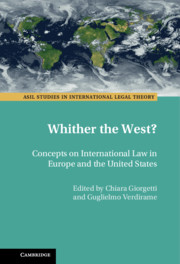Book contents
- Whither the West?
- ASIL Studies in International Legal Theory
- Whither the West?
- Copyright page
- Contents
- About the Authors
- Acknowledgements
- Introduction
- I The Idea of International Law in the Divided West
- 1 International Lawyers and Legal Forms
- 2 Are We (Americans) All International Legal Realists Now?
- 3 Are Liberal Internationalists Still Liberal?
- 4 The New, New Sovereigntism, or How the European Union Became Disenchanted with International Law and Defiantly Protective of Its Domestic Legal Order
- II Specific Areas in International Law: Whither the West?
4 - The New, New Sovereigntism, or How the European Union Became Disenchanted with International Law and Defiantly Protective of Its Domestic Legal Order
from I - The Idea of International Law in the Divided West
Published online by Cambridge University Press: 29 April 2021
- Whither the West?
- ASIL Studies in International Legal Theory
- Whither the West?
- Copyright page
- Contents
- About the Authors
- Acknowledgements
- Introduction
- I The Idea of International Law in the Divided West
- 1 International Lawyers and Legal Forms
- 2 Are We (Americans) All International Legal Realists Now?
- 3 Are Liberal Internationalists Still Liberal?
- 4 The New, New Sovereigntism, or How the European Union Became Disenchanted with International Law and Defiantly Protective of Its Domestic Legal Order
- II Specific Areas in International Law: Whither the West?
Summary
Pollack documents the rise of a “new, new sovereigntism” emanating from Europe. He locates this new sovereigntism not within the far-right, but within pro-European parties and movement and primarily on the left and center-left of the political spectrum, that is those that seek to defend EU laws and EU legal order against the intrusion of a growing body of public international law to which they object. Their objections are based on the claims that international-law making and interpretation are procedurally flawed, and that some international legal norms are antithetical to fundamental rights in Europe and, above all, that the European legal order must be protected. Pollack focuses on three recent developments in international law: (1) the Anti-Counterfeiting Trade Agreement, rejected by EU institutions for failing to protect the rights of EU citizens; (2) the proposed Transatlantic Trade and Investment Partnership and the Comprehensive Economic and Trade Agreement, both denounced by political leaders and civil society; and (3) the Union’s longrunning rejection of the WTO rulings on hormone-treated beef and genetically modified foods. Pollack finds that new European sovereigntism is not identical to its American sovereigntism, but a genuinely new phenomenon, as Europe for decades has been characterized by a mainstream, consensual and almost uncritical enthusiasm for international law.
Keywords
- Type
- Chapter
- Information
- Whither the West?International Law in Europe and the United States, pp. 73 - 112Publisher: Cambridge University PressPrint publication year: 2021
- 2
- Cited by

